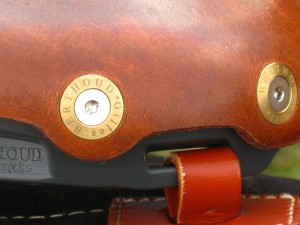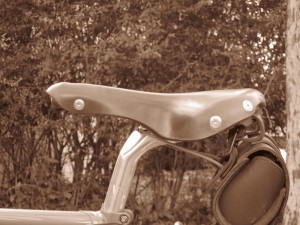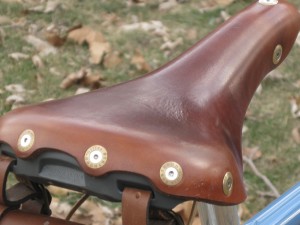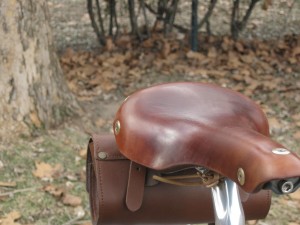
I now have over 3000 miles on my Gilles Berthoud Aspin touring saddle, so I guess I feel OK about sharing my impressions. (the pun will become apparent later) The Gilles Berthoud Company is located in Pont de Vaux, France. The products they produce are well thought out and elegant and, as far as I can tell, any compromise in materials or methods used in construction is never considered. The leather saddles are unique in several ways. The cantle plate and nose piece are made of a special, composite material. The rails, either steel or titanium, depending on the model, slide into holes molded into the composite pieces. The leather tops are bolted on with stainless steel bolts and specially designed brass washers which have the Gilles Berthoud name engraved on them except the nose rivet which has the individual saddle’s number on it. The idea being that individual pieces of the saddle can be easily replaced. The tension on the leather top can be adjusted with a 5 mm allen wrench so no special tool is required as on Brooks saddles. The leather is supposed to be waterproof and Gilles Berthoud does sell a proprietary leather treatment.
Being able to take the saddle apart may be a good idea, but I have noticed a couple of things one needs to pay attention to. If you pick up a 60 pound touring bike by grabbing the rear of the saddle, the rails may pop out of the cantle plate. It is possible to loosen the tensioning bolt enough to pop them back in place and the saddle is good as new, but US 77 outside of La Grange TX is not the best place to go through this exercise. The bolts holding the leather top on can come loose and need to be checked and tightened periodically. We also discovered that the dye used in the black saddles leaves an unsatisfactory stain on lighter colored pants. The natural saddles don’t appear to have that feature.
The bottom line is that this is the most supremely comfortable saddle I have ever used. The leather appears to be thicker than that on some other brands but it has been pre-softened, and rather than simply sagging or splaying out with use has conformed to my anatomy leaving the impressions of my sit bones. Yet it gives enough support that there is no pressure on the soft tissue parts of the perineum or the arteries and blood vessels. In short, no pain and no genital numbness! As with any saddle, especially leather ones, adjustment of the fore/aft tilt is critical to comfort.
The section of rail that can be clamped to the seatpost is short, like on Brooks saddles so the fore and aft positioning of the saddle is limited, but a set back seat post can help if a farther aft position is desired.


These saddles are not inexpensive, over two times the price of a Brooks B17, but to my mind (not to mention other parts) they are well worth it. After 4 or 5 or 6 hours in the saddle when touring, it’s nice to not have a literal pain in the butt to worry about. The durability of my saddle so far has been terrific allowing for the mentioned caveats. Those are two things that figure into my calculations of value.

